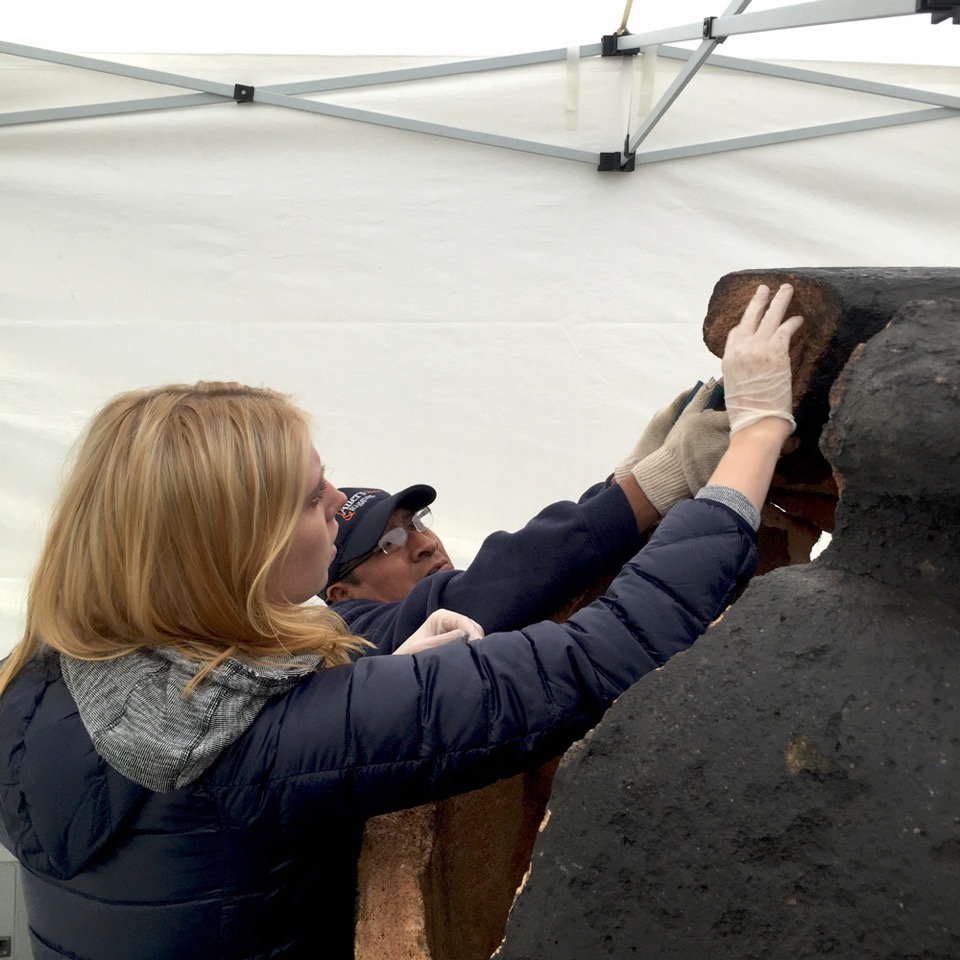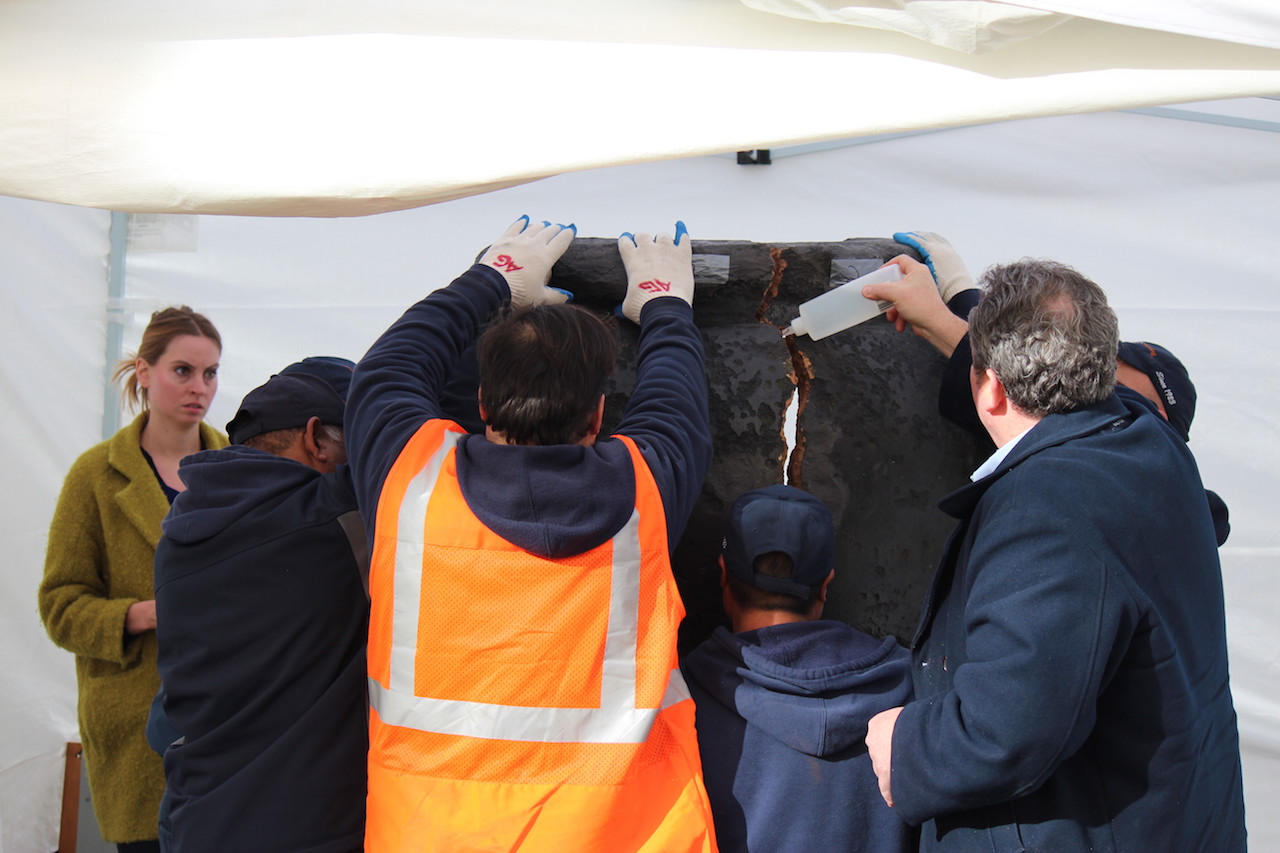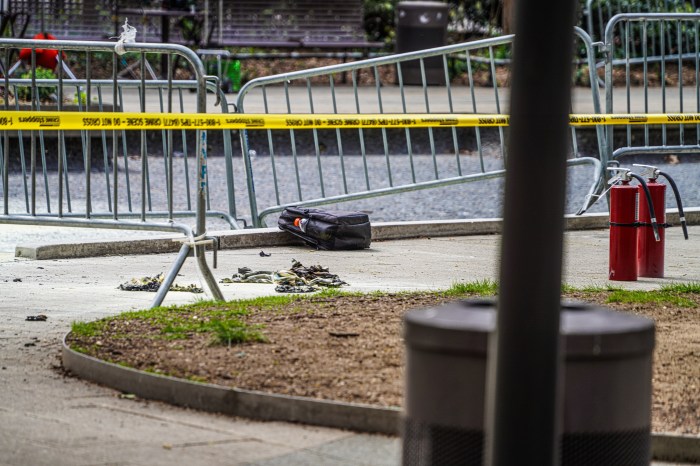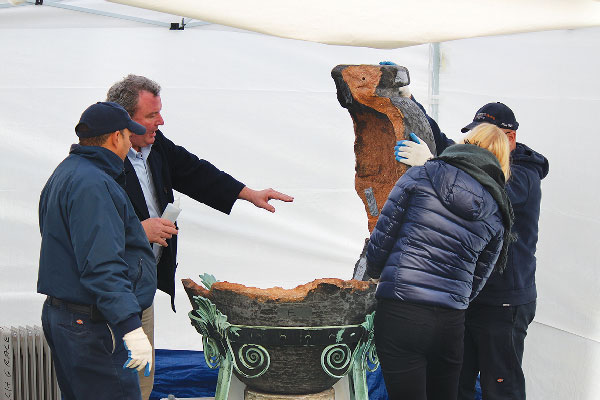
Conservators Lansing Moore (holding a bottle of HXTAL epoxy) and Melissa Barton, right, and a team of riggers reassembling the renovated Roman urn in the Grace Church yard last Thursday. The plan was to let the epoxy holding the urn’s pieces together “cure” for a few days, before removing the protective white tent over the urn.
BY ALBERT AMATEAU | You may not have noticed that the giant urn that has graced the Rector’s Garden at the landmarked Grace Church for the past 130 years has been gone since last May.
Noticed or not, the 5-foot-tall urn, dating as far back as 2,000 years to the Roman Empire, returned on Thurs., Dec. 3, to the Grace Church yard on Broadway at 11th St.
For the past few weeks, a 10-foot white weatherproof tent has been occupying the space where the urn was reassembled last week.
The Reverend Donald Waring, rector of Grace Church, took the occasion to speak with The Villager about the urn that has long decorated the front yard of the 1846 church designed by James Renwick.
“Last Easter we noticed that a huge chunk had broken off the urn,” Waring said. “It had sort of an iconic status in the neighborhood; the downtown side of the subway station even has an image in tile of the urn, so we thought we should have it restored.”
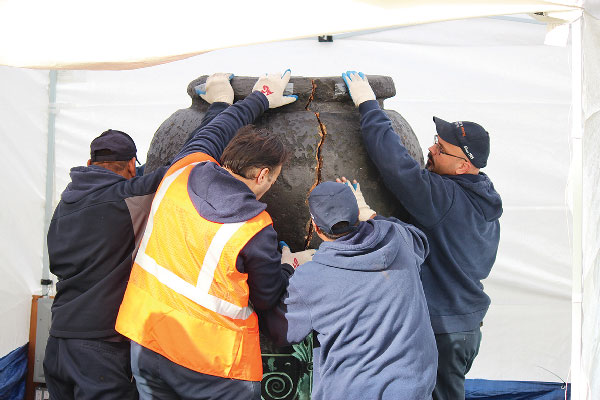 Center Art Studio, a 96-year old restoration firm, was called and discovered that the terra-cotta urn was in really bad condition after more than a century of exposure to the freeze-and-thaw cycles of New York winters. So the firm took it to their W. 38th St. studio.
Center Art Studio, a 96-year old restoration firm, was called and discovered that the terra-cotta urn was in really bad condition after more than a century of exposure to the freeze-and-thaw cycles of New York winters. So the firm took it to their W. 38th St. studio.
“Aside from Cleopatra’s Needle in Central Park, this urn — “dolium” in Latin — is the largest piece of ancient outdoor art in the city,” said Lansing Moore, owner of Center Art. “The place in Rome where it was found in the 1880s was near the site of Nero’s palace.
“It was in much worse condition than we expected,” Moore said. “We contracted Auer’s Rigging, the oldest riggers in the city — they move and store art for the Metropolitan Museum of Art and other institutions. But the urn was spalling — layers of terra-cotta were flaking off the outside — and it broke up. We took it to the studio in about 90 pieces,” Moore recalled.
Grace Church had expected a neighborhood outcry when the urn, more than 5 feet tall, 4 feet in diameter at its widest, and sitting on an 18-inch marble base with a 19th-century Italian bronze ring, was gone in the beginning of May.
“We thought we’d get anxious questions because it was such a neighborhood curiosity,” Waring said. “It didn’t have a lid, and people used to toss pennies into it, and sometimes teens would climb into it. But no one asked us anything; we didn’t hear a peep.”
At the Center Art Studio, the urn, whose walls are about 3 inches thick, was painstakingly reassembled into seven large pieces. Melissa Barton, a restorer at Center Art, began researching terra-cotta restoration and found Roma Bio, of Atlanta, Georgia, a company that developed a modern stucco resin based on the ancient pozzolana cement perfected by the Romans.
“We sent them a sample of the terra-cotta and they matched the color,” said Barton, adding “It has an important added benefit; it’s freeze-and-thaw resistant.”
So how did a Roman urn wind up at Grace Church?
In the 1880s, Grace Church helped fund the building of a new rectory for an American Episcopal Church in Rome, St. Paul’s Within the Walls. The excavation for the new building uncovered 12 huge terra-cotta urns buried in the basement of what was apparently a Roman public eating place, according to Waring.
The then-rector of Grace Church, William Reed Huntington, was in Rome at the time and took a liking to the urns.
“He suggested to the rector of St. Paul’s Within the Walls that in consideration of Grace Church’s monetary gift for the new rectory, St. Paul’s should give one of the urns to Grace Church,” Waring said. The rector of St. Paul’s agreed.
“Then, Catharine Lorillard Wolfe, an art collector and prominent benefactor of Grace Church — her portrait is on a wall of the Grace Church rectory — said ‘I’ll have one, too.’ Her urn is in her Newport, Rhode Island, mansion. It’s now a school, and the urn is in great condition, never having been exposed to the weather,” Waring said. Wolfe was one of the 106 founders of the Metropolitan Museum of Art and the only woman.
“The urns would have been buried up to their necks in the basement of the original refectory,” Waring said. “They probably held wheat, rice or other grains. In the subsequent centuries, the original Roman building was demolished and the urns were buried and forgotten, until the excavation for the new St. Paul’s Within the Walls rectory brought them to light again.”
Last Thursday, it took four hours for a crew from Auer’s Rigging to get the seven pieces of the reassembled urn in their final position.
“We couldn’t have done it without Auer’s and Roma Bio in Atlanta,” said Moore, who also acknowledged the help of Pete Hogden, in charge of buildings and grounds at Grace Church.
The complex and expensive project was being completed under the heated tent this week. Once the urn’s epoxy has “cured,” the tent will be removed.
The restoration of the dolium cost more than the $12,000 bill that Center Art submitted to the church. The transport and restoration of the dolium cost a total of more than $25,o00.
“We love antiquities, and we do things like this for nonprofit institutions at a discount,” Moore said.
“We’ll gladly accept donations from a benefactor whose name could be put on the marble base of the urn,” said Waring.



